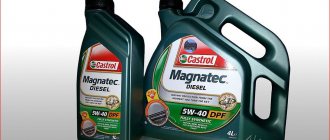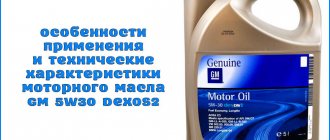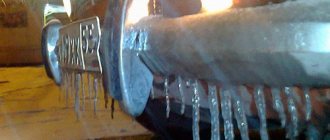Many domestic car enthusiasts are learning to independently cope with the problems created by harsh weather conditions. After all, unlike the inhabitants of hot countries who are not familiar with winter surprises, they sometimes have to deal with ice, the unexpected appearance of snowdrifts that make it difficult to travel, and other troubles caused by the peculiarities of the local climate.
The upcoming publication will help you not to panic if the engine oil suddenly freezes. How to painlessly resolve the issue of starting the engine in such a situation, what devices should always be on hand so that the car does not refuse to perform its intended functions, you can find out by carefully studying the information provided.
After parking overnight in an open area in winter, the engine oil froze. What should a car enthusiast do to get the car to start and drive?
Unfortunately, not every owner of a personal vehicle properly follows the manufacturer’s recommendations, which clearly regulate the use of a certain type of lubricant. The consequences of such a careless attitude towards the car will be discussed a little later. First, let's take a closer look at the existing types of lubricating oil products used to ensure safe engine operation.
This information will allow you to better navigate among the variety of products supplied to the modern market. The information obtained will help the ignorant motorist make the right choice of engine oil for each specific car, taking into account operating conditions.
Types of motor lubrication
It should be noted that motor oil is a special substance that protects individual parts of a car engine from premature wear caused by constant friction of moving elements. Depending on the composition, such lubricant is divided into three main types:
- mineral oils obtained by special processing of crude oil, after preliminary purification of this natural product. Among their advantages are reasonable cost and ease of production. The disadvantages are the need for too frequent replacement in parallel with a very limited operating temperature range;
- semi-synthetic oils obtained by diluting the mineral base with certain synthetic additives. The natural component of such a lubricant is determined to be 50-70%, and the amount of artificial additives, accordingly, ranges from 30-50%. In terms of quality characteristics, semi-synthetic oils are significantly superior to mineral ones, and the cost is much cheaper than synthetic ones;
- synthetic lubricant obtained from the products of primary distillation of oil through special processing. It is characterized by excellent fluidity, the ability to work in an extended temperature range, and the ability to maintain its original qualities during operation for a long time, without the need for frequent replacement.
Based on the listed characteristics, it is easy to understand which oil is recommended for use in winter. This is especially true in regions where severe frosts are observed.
Tips for choosing a lubricant
What oil fluid should I buy to ensure reliable protection of the parts of my own car? Your best bet, of course, is to choose a product that your auto manufacturer recommends. Determining the optimal characteristics of a petroleum product for an engine is a complex process. The manufacturer conducts many different tests to determine which oil will be most suitable for any engine.
In real conditions, the range of permissible temperature conditions may expand. This is due to the climate, which in the Russian Federation is quite harsh (especially in winter). Every car owner should be able to select the optimal lubricant, based on the recommendations of the manufacturer of their car, as well as on real road conditions.
- The car engine will immediately turn off.
- Minimize the load on the power unit by reducing speed.
- Turn on the car furnace for the maximum possible airflow, which will allow you to effectively and quickly remove superheated air from the working part of the car engine.
- If there is such an opportunity, then it is advisable to drive along a coasting road to quickly cool the engine compartment.
- After stopping the car completely, you need to wait at least 5 minutes and only then turn off the engine.
Groups of motor lubricants
In addition to the composition, the classification of motor oils depends on the temperature conditions in which the car engine operates. Here the influence of the viscosity of the lubricant is observed. Depending on this parameter, existing types of motor oils are divided into three groups:
- summer grease is characterized by increased viscosity. Used mainly in hot weather. Summer oil can provide quite reliable protection to an engine operating at fairly high temperatures. Its use is not recommended for starting and subsequent operation of a car engine at subzero temperatures. Any oil, regardless of the base, both mineral and synthetic, can act as a summer lubricant;
- Winter oil is characterized by reduced viscosity with improved fluidity. It is able to reliably protect the engine in cold weather due to better penetration through the channels. However, at high ambient temperatures it loses the ability to properly perform its functions, so summer heat is an unacceptable operating mode for it. For winter lubrication, predominantly synthetic oils are used;
- All-season oil is considered universal, the viscosity of which does not change significantly even with significant temperature changes. Its advantage over seasonal lubrication is justified by the absence of the need for replacement when a certain time of year approaches, every six months. Synthetic and semi-synthetic oils are universal.
Of course, a reasonable car owner who takes good care of his personal vehicle will not take risks by filling his car with summer oil in the winter cold. However, changing weather conditions are not always possible to predict.
There are times when frost takes the driver by surprise, preventing him from properly preparing for the new season. The next section is devoted to the dangers that await a car engine in which the lubricant has frozen.
Pour point
The indicator is determined at the moment the oil viscosity increases until it loses fluidity. In laboratory conditions, the pour point is considered the lower limit at which the liquid in a test tube at an angle of 45 degrees does not drain within 1 minute and remains motionless. The low-temperature characteristics of the oil directly depend on the composition and quality of the components. In oil refining products, viscosity increases with the crystallization of paraffins of normal structure. Therefore, the base undergoes thorough cleaning or chemical modification to branch the structure of the components and reduce the pour point. Synthetic oils have a more uniform and predictable composition, which reduces the crystallization threshold and provides the material with stable properties in cold weather.
Why is engine oil freezing dangerous for your car?
Unlike civilized countries, it is all too common for domestic car enthusiasts to have to leave their car in an unheated parking lot in winter, or even under the windows of a multi-story building. Of course, at above-zero temperatures this is not dangerous, however, in cold weather various troubles can happen to the vehicle.
For example, ice forms in the engine or the oil freezes. Let's take a closer look at the dangers thickened lubricant in the engine poses for a car:
- The main purpose of the oil is to protect functional engine parts from excessive friction, which prevents their premature wear. An unexpected drop in temperature can cause motor lubricant to freeze, which causes unwanted solidification, affecting the performance characteristics of the oil product. First of all, this affects the operation of the crankshaft, preventing it from turning freely. As a result, it becomes difficult to start the engine, making it impossible to move the car;
- It is advisable not to allow the engine oil to thicken, as this may cause unacceptable rotation of the liners. Therefore, starting an engine with frozen lubricant is strictly prohibited;
- Without creating the required protective film on the moving elements of a car engine, thickened oil can lead to failure of the power unit. Overhauling an engine takes not only significant financial resources, but also nerve cells, traumatizing the psyche of the owner, who is already quite concerned about the fight against winter weather surprises, like snow drifts or ice.
So, the information provided undoubtedly convinced us that it is inadmissible to start the engine with frozen lubricant. To avoid the above troubles, it is better to deliver the car by tow or tow truck to a warm place, where it is left until the engine is completely warmed up.
However, there are situations that dictate an urgent need for a car at that particular moment. What should a driver who has left a vehicle outside overnight in freezing weather do if he urgently needs to go somewhere?
Before you take any measures to eliminate the problem, you must determine the cause of its occurrence. This will help determine the best way out of the current situation.
Assess the color of the oil
Sometimes scammers fill canisters with used oil that has been passed through simple fine filters. This removes engine wear products, metal shavings, soot and precipitated additives. The resulting substance is then sold again under the guise of new oil. However, it is already significantly inferior in terms of characteristics to the new product. You can distinguish it by color. The new oil has the amber color of liquid honey. And the waste distilled through filters gives off a dark shade of melted caramel.
In general, there are simple ways to protect yourself from counterfeit products. If you do not buy cans in markets and in dubious stores, and also check the oil using the described methods before pouring it into the engine, then the chances of pouring a low-quality product into the crankcase are noticeably reduced.
Causes of oil freezing in a car engine
Manufacturers of motor lubricants clearly indicate the compliance of the petroleum product with a specific type of engine. Of course, when choosing a suitable material, you should take into account the operating conditions.
For drivers who often use a vehicle in cold weather, it is recommended to conduct a freezing test of motor oils before purchasing. This procedure is quite simple and guarantees the proper condition of the motor lubrication in certain climatic conditions.
There are several prerequisites that lead to an undesirable situation when it is discovered that the oil in the car’s engine has frozen overnight. Let's look at them in more detail:
- One of the known reasons is the exhausted life of the lubricant. Therefore, it is so important to pay attention to the expiration date of the petroleum product indicated by the manufacturer on the packaging;
- Also, you should not show inappropriate thriftiness by purchasing low-quality counterfeit oil. All kinds of untested additives contained in such a lubricant can lead to freezing of the petroleum product;
- Sometimes when choosing engine oil, they forget to take into account the climatic conditions of a certain region in which the car is used. For temperatures below −250 C, 5W, and possibly even 0W, product brands are recommended. This choice guarantees a confident cold start with normal cranking.
The reasons listed apply to cars with a new engine. It is almost impossible to predict oil freezing in an old engine. Therefore, it is better to take care of its insulation in advance or install pre-heaters.
What to do if the oil boils?
If you are stuck in a traffic jam or in a parking space and notice oil burning, turn off the engine immediately. There is no need to panic, the main thing is to stop the engine.
If smoke appears from the engine compartment while driving, stop the car as follows:
- Minimize the load on the power plant - to do this, take your foot off the gas pedal to lower the speed.
- Turn on the car heater to maximum airflow - this will remove some of the overheated air from the working area and reduce its concentration in the engine.
- If road conditions permit, coast until the vehicle comes to a complete stop. The oncoming wind will cool the engine compartment.
- As soon as the car stops, wait another 5 minutes and only then turn off the engine.
Remember! When the temperature inside the propulsion system increases, sudden braking of the vehicle should not be allowed.
Possible methods for warming frozen motor oil
It is not always possible to avoid frost-induced thickening of the lubricant. If a problem is detected, do not try to start the engine. It is best to deliver the damaged car to a warm garage in tow or with the help of a tow truck, after natural heating, drain the unusable oil and fill the engine with a more suitable petroleum product.
If you need to urgently go somewhere, experienced car enthusiasts recommend the following methods for defrosting the engine:
- Using a hair dryer or other heater gradually warms up the engine sump. Periodically checking the condition of the oil with a dipstick, bring it to an acceptable consistency, after which you can start the car;
- It may be possible to use heat from a blowtorch delivered to the engine through a piece of pipe. This method must not be used if there is an oil leak;
- A heat gun running on diesel fuel or gasoline can instantly solve the problem. Drivers who spend money on purchasing it in the winter will recoup their investment by saving on electricity.
Main signs of an oil flash
According to the observations of experienced motorists, there are four main signs of a lubricant flash:
- Sudden change in thermostat readings. Each car is equipped with a special indicator that monitors the heating level of the lubricant. With a normally warmed-up engine, the instrument needle points to the average value. If the arrow begins to approach the red line, then this indicates that there is a problem with oil exchange.
- Characteristic sound of boiling. When the lubricant boils and then flashes, the motorist may hear a characteristic sound.
- Smoke appears. If smoke comes from the engine compartment, then most likely there is a boiling and flash of the lubricant.
- The appearance of black smoke from the exhaust pipe. This sign indicates that the problem with excessive lubricant temperature has reached an unpredictable level.
Reasons for the problem
Let's look at the reasons why the engine oil temperature begins to rise:
- The main reason for the increase in the operating temperature of the protective lubricant is its low quality. If you are trying to save money on the maintenance of your vehicle, immediately prepare for unpleasant surprises in its operation. Low-quality motor oil cannot cope with constant temperature fluctuations inside the power plant: it quickly loses its performance properties, turning into a watery liquid, which not only begins to rapidly drain from the mechanisms, leaving them without protection, but also begins to burn and evaporate.
A similar situation occurs with a high-quality lubricant after it has become obsolete.
If the car owner neglects to change the oil, the oil product can also cause an increase in temperature inside the engine system.
- Faults in the cooling system can also cause the oil temperature to rise sharply. For example, this can be caused by a break or loosening of the fan drive belt or cooling system pump, a malfunction of the fan drive fluid coupling, contamination of the radiator and other design imperfections.
These are the two main reasons that can cause oil to boil inside the power plant.
What's the result?
At best, repair of important engine components, and at worst, the car is sent for overhaul with replacement of the engine and related systems. That is why it is necessary to understand exactly what each temperature mode of motor oil is responsible for, and how to correctly use the data on the packaging, choosing only high-quality, proven products.
Viscosity is indicated directly on the canister. It consists of a complex number. Viscosity in this case is designated like this - 5w40, where w is the first letter of the English word winter, which is translated as “winter”. The number or numbers to the left of w indicate the winter parameter, and to the right of w the summer parameter. You need to deal with the winter period.
The smaller the number to the left of w, the lower the temperature the oil is designed for. It is worth remembering the magic number “35”. Why her? If you subtract 35 degrees from the first viscosity number 5w, then the resulting result (-35°C) will be the minimum permissible temperature at which it is possible to crank the engine with the starter.
Whether the engine will start at this temperature or not is another question. A lot depends on:
- Engine designs.
- Technical condition of the motor.
- Fuel system conditions.
- Battery and fuel conditions.
The number circulating among motorists is not 35, but 40 (oil 10w40). What does it mean? This is the temperature at which oil can be pumped by an oil pump; in these cases, critical changes occur - friction units fail. A difference of five degrees is the last insurance for a car engine; you cannot match this figure. Below is the viscosity table.
The temperature range can be very wide. When the engine warms up to operating condition, the oil viscosity decreases to normal. The operating temperature of the engine does not exceed the norm for its load and is within the permissible temperature range. The engine life does not increase even with a high thermometer reading and can work for quite a long time.
High engine temperatures are much more dangerous than low temperatures. Overheating may bring the oil to a boil. If you do not pay attention to this, problems will arise in the future. The grease reaches a boil at 250-260 °C and begins to smoke and bubble.
If the high temperature is maintained for a long time, the viscosity decreases and the parts cannot be properly lubricated.
When the temperature rises to 125°C, irreversible consequences occur and the oil begins to evaporate along with the fuel, bypassing the piston rings.
The concentration of the product becomes quite low - when exhausted it will not be visible at all. The rate of consumption increases, so it must be constantly topped up. If the oil level has dropped, you need to top it up to the optimal level. During boiling, the product loses its original properties and viscosity.









